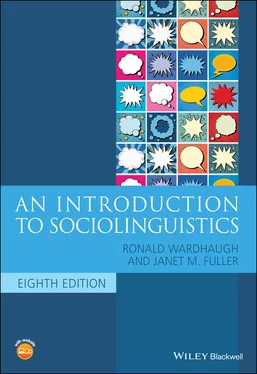In the case of Kiezdeutsch , this term was chosen by researchers because other terms used to refer to the variety in everyday speech were inaccurate (e.g., Türken ‐ deutsch , ‘Turks’ German’) and potentially offensive (e.g., Kanak Sprak , derived from a derogatory term for foreigners [ Kanak or Kanaker ] and nonstandard spelling/pronunciation of German Sprache ‘language’). However, as this case illustrates, no term is perfect. The term Kiez varies regionally in how it is used; in Berlin it is commonly used in a positive manner to refer to one’s neighborhood, indicating it is where one feels at home, but in Hamburg the term is used to refer to one particular neighborhood, the so‐called red light district. (As we will see in our discussion of African American Vernacular English and Latino Englishes below, labels for varieties are often problematic and sites of controversy; this issue will also be discussed further in the next chapter as we attempt to define social groups.)
While certain features of Kiezdeutsch do not seem to be disputed, the development and status of these features are. Wiese (2010, 2012) argues that although Kiezdeutsch does include some lexical items from languages other than German (often, Turkish), it is not a mixed language (see chapter 9for a definition of this term); instead, the grammatical features have their roots in the German language. She refers to Kiezdeutsch as a German dialect. Auer (2013, 36) disputes this, saying it is simply a youth style of speaking which is not used consistently enough to be considered a dialect, and suggests that there are features indicating ‘unsichere Beherrschung der deutschen Morphologie’ (‘uncertain mastery of German morphology’); Glück (2017) also dismisses Wiese’s findings as the transitional speech of children and not a dialect, social or regional. Similarly, Jannedy (2010) calls Kiezdeutsch a ‘multi‐ethnolectal youth language,’ and not a social dialect.
Popular opinion about nonstandard social dialects is often that these ways of speaking are lazy, sloppy, and degenerate. Wiese (2012) aims at convincing a general audience that the features of Kiezdeutsch are part of normal language development and variation, not a bastardization through foreign influence, but this position has caused great consternation for many readers, who do not want to accept that a new dialect is possible (see Wiese 2014 for an analysis of this discourse).
Who speaks Kiezdeutsch is also represented in the literature in different ways. There is agreement that its speakers generally live in multiethnic neighborhoods, and it is referred to as a youth language, but whether it is indeed limited to young speakers has not been conclusively demonstrated. Auer (2013) discusses the speakers of Kiezdeutsch as socially marginalized youths of immigrant background, while among Wiese’s research participants are speakers with German backgrounds who are monolingual German speakers (as well as speakers of other ethnic or national backgrounds who are monolingual German speakers). More recent attitudinal research (Bunk and Pohle 2019) shows that while non‐Kiezdeutsch speakers may associate the variety with ethnicity, the speakers themselves recognize their way of speaking as indexing educational failure, economic disadvantage, and a ‘gangster image’ (2019, 98). Significantly, these speakers also identify this way of speaking as just one code in their repertoires, reporting that while they use Kiezdeutsch among friends, they speak Standard German in more formal contexts.
Finally, the process of the development of this variety is controversial. It is often assumed to be the result of language contact, meaning that the features are borrowed from other languages, especially Turkish (e.g., Auer 2013). Wiese (2010, 2012) argues for a somewhat different scenario: that this situation of language contact has created a fertile environment for internally motivated language change (see chapters 5and 9for discussions of contact variety development and language change more broadly).
What is clear is that Kiezdeutsch is a variety which has developed as an ingroup language; the development and use of Kiezdeutsch is intertwined with the identities of the speakers. As will be discussed for ethnic dialects, the identification with a group is a key element in the development of a social dialect.
So‐called ethnic dialects do not arise because members of particular ethnic groups are somehow destined to speak in certain ways; like all other social dialects, ethnic dialects are learned by exposure and anyone, regardless of their ethnic identification or racial categorization, might speak in ways identified as ‘African American Vernacular English’ or ‘Latinx English.’ The connection between race/ethnicity/nationality and linguistic variety is one that is entirely socially constructed, thus these varieties would perhaps best be described as ‘ethnicized.’
The processes that create ethnic dialects are not well understood, and much research remains to be done into how and why they develop. However, we do know that ethnic dialects are not simply foreign accents of the majority language; many of their speakers may well be monolingual in the majority language. Latinx English, for example, is not English with a Spanish accent and grammatical transfer, as many of its speakers are English monolinguals. Ethnic dialects are ingroup ways of speaking the majority language.
One study which gives us insights into the motivations for the development of an ethnic dialect was done by Kopp (1999) on Pennsylvania German English, that is, the English spoken among speakers of what is commonly called ‘Pennsylvania Dutch,’ which is a German dialect which developed in certain regions of Pennsylvania. Kopp analyzes a variety of features associated with speakers of Pennsylvania German in both sectarian (i.e., Amish and Mennonite) and nonsectarian communities. He discovers what at first seems to be a paradoxical pattern: although the sectarians are more isolated from mainstream society, and they continue to speak Pennsylvania German, their English has fewer phonological features that identify them as Pennsylvania German speakers than the nonsectarians, who are integrated into the English mainstream and less likely to be speakers of Pennsylvania German. So the nonsectarians, who are in many cases English monolinguals, exhibit more phonological features reminiscent of a Pennsylvania German accent in their spoken English than the sectarians! As Kopp explains, this makes perfect sense when we think of language as providing a way to construct identity. The sectarians speak Pennsylvania German, and thus can use that language to create group boundaries; the nonsectarians, who increasingly do not speak Pennsylvania German, have only their variety of English to use to construct themselves as members of a particular ethnic group.
Although Pennsylvania German English developed largely in rural areas, many ethnic dialects are urban phenomena. Cities are much more difficult to characterize linguistically than are rural hamlets; variation in language and patterns of change are much more obvious in cities, for example, in family structures, employment, and opportunities for social advancement or decline. Migration, both in and out of cities, is also usually a potent linguistic factor. Recent research on superdiversityfocuses on this aspect of language contact and development and will be discussed further in chapter 10.
In research which examines the complexities of urban speech, Jaspers (2008) also addresses some of the ideological issues at stake in the study of ethnic dialects. He addresses the practice of naming particular ways of speaking as ethnolects, pointing out that it is indicative of the ideological positions of the sociolinguists doing the research themselves. Labeling and describing a particular way of speaking as an ethnic dialect implies a certain homogeneity about the variety and its speakers, and it inevitably also places the dialect and the group who speaks it outside the mainstream. Further, such labeled varieties are not always linguistically distinct, despite the perception of speakers. Jaspers writes (2008, 100):
Читать дальше




![Andrew Radford - Linguistics An Introduction [Second Edition]](/books/397851/andrew-radford-linguistics-an-introduction-second-thumb.webp)







